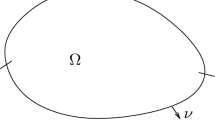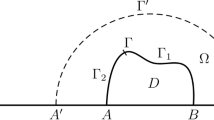Abstract
In this paper, we intend to formulate and solve Cauchy problems for the Brinkman equations governing the flow of fluids in porous media, which have never been investigated before in such an inverse formulation. The physical scenario corresponds to situations where part of the boundary of the fluid domain is hostile or inaccessible, whilst on the remaining friendly part of the boundary we prescribe or measure both the fluid velocity and traction. The resulting mathematical formulation leads to a linear but ill-posed problem. A convergent algorithm based on solving two sub-sequences of mixed direct problems is developed. The direct solver is based on the method of fundamental solutions which is a meshless boundary collocation method. Since the investigated problem is ill-posed, the iterative process is stopped according to the discrepancy principle at a threshold given by the amount of noise with which the input measured data is contaminated in order to prevent the manifestation of instability. Results inverting both exact and noisy data for two- and three-dimensional problems demonstrate the convergence and stability of the proposed numerical algorithm.












Similar content being viewed by others
Data Availability
No datasets were generated or analysed during the current study.
References
Bastay, G., Johansson, B.T., Kozlov, V.A., Lesnic, D.: An alternating method for the stationary Stokes system. ZAMM 86, 268–280 (2006)
Baumeister, J., Leitao, A.: On iterative methods for solving ill-posed problems modeled by partial differential equations. J. Inverse Ill-Posed Probl. 9, 13–29 (2001)
Brinkman, H.C.: A calculation of the viscous force exerted by a flowing fluid is a dense swarm of particles. Appl. Sci. Res. A 1, 27–34 (1949)
Durlofsky, L., Brady, J.F.: Analysis of the Brinkman equation as a model for flows in porous media. Phys. Fluids 30, 3329–3341 (1987)
Fabre, C., Lebeau, G.: Prolongement unique des solutions de l’equation de Stokes. Commun. Partial Differ. Equ. 21, 573–596 (1996)
Hardin, D.P., Michaels, T., Saff, E.B.: A comparison of popular point configurations on \(\mathbb{S}^2\). Dolomites Res. Notes Approx. 9, 16–49 (2016)
Johansson, T.: An iterative procedure for solving a Cauchy problem for second order elliptic equations. Mathematische Nachrichten 272, 46–54 (2004)
Johansson, T., Lesnic, D.: Reconstruction of a stationary flow from incomplete boundary data using iterative methods. Eur. J. Appl. Math. 17, 651–663 (2006)
Johansson, B.T., Kozlov, V.A.: An alternating method for Cauchy problems for Helmholtz-type operators in non-homogeneous medium. IMA J. Appl. Math. 74, 62–73 (2009)
Karageorghis, A., Lesnic, D., Marin, L.: The method of fundamental solutions for Brinkman flows. Part I. Exterior domains. J. Eng. Math. 126(10), 12 (2021)
Karageorghis, A., Lesnic, D., Marin, L.: The method of fundamental solutions for Brinkman flows. Part II. Interior domains. J. Eng. Math. 127(19), 12 (2021)
Kohr, M.: A mixed boundary value problem for the unsteady Stokes system in a bounded domain in \(\mathbb{R}^n\). Eng. Anal. Bound. Elem. 29, 936–943 (2005)
Kohr, M., Raja Sekhar, G.P., Blake, J.R.: Green’s function of the Brinkman equation in a 2D anisotropic case. IMA J. Appl. Math. 73, 374–392 (2008)
Kozlov, V.A., Maz’ya, V.G., Fomin, A.V.: An iterative method for solving the Cauchy problem for elliptic equations. U.S.S.R. Comput. Math. Math. Phys. 31, 45–52 (1991)
Ligaarden, I. S., Krotkiewski, M., Lie, K.-A., Paland, M., Schmid, D. W.: On the Stokes–Brinkman equations for modelling flow in carbonate reservoirs, In: Proceedings of the ECMOR XII – 12th European Conference on the Mathematics of Oil Recovery, 6–9 September 2010, (2010) Oxford, UK
Liu, H., Patil, P.R., Narusawa, U.: On Darcy-Brinkman equation: viscous flow between two parallel plates packed with regular square arrays of cylinders. Entropy 9, 118–131 (2007)
Marin, L., Karageorghis, A., Lesnic, D.: A numerical study of the SVD-MFS solution of inverse boundary problems in two-dimensional steady-state linear thermoelasticity. Numer. Methods Partial Differ. Equ. 31, 168–201 (2015)
Martin, P.A.: Two-dimensional Brinkman flows and their relation to analogous Stokes flows. IMA J. Appl. Math. 84, 912–929 (2019)
Martins, N.F.M., Rebelo, M.: Meshfree methods for non-homogeneous Brinkman flows. Comput. Math. Appl. 68, 872–886 (2014)
Martins, N.F.M.: Identification results for inverse source problems in unsteady Stokes flows. Inverse Probl. 31(17), 015004 (2015)
N. F. M. Martins, Direct and optimization methods for the localization of obstacles in porous media, In Rodrigues, H., et al. (eds.) Engineering Optimization IV, Taylor & Francis Group, London, pp. 991–996 (2015)
Maxwell, D.: Kozlov-Maz’ya iteration as a form of Landweber iteration. Inverse Probl. Imaging 8, 537–560 (2014)
Pozrikidis, C.: Boundary Integral and Singularity Methods for Linearized Viscous Flow. Cambridge University Press, Cambridge (1992)
Tsai, C.C.: Solutions of slow Brinkman flows using the method of fundamental solutions. Int. J. Numer. Methods Fluids 56, 927–940 (2008)
Varnhorn, W.: The boundary value problems of the Stokes resolvent equations in \(n\) dimensions. Mathematische Nachrichten 267–270, 210–230 (2004)
Acknowledgements
No data are associated with this article. For the purpose of open access, the authors have applied a Creative Commons Attribution (CC BY) licence to any Author Accepted Manuscript version arising from this submission.
Author information
Authors and Affiliations
Contributions
Both authors contributed equally.
Corresponding author
Ethics declarations
Ethics approval
Not applicable.
Competing interests
The authors declare no competing interests.
Additional information
Publisher's Note
Springer Nature remains neutral with regard to jurisdictional claims in published maps and institutional affiliations.
Appendix
Appendix
In three dimensions, we approximate the fluid velocity \({\varvec{u} }= ( u_1, u_2, u_3)\) and the pressure p by \({\varvec{u} }_N= ( u_{N_1}, u_{N_2}, u_{N_3})\) and \(p_N\), respectively, where
and the pressure p by \(p_N\) where
where
is the fundamental solution of the three-dimensional Brinkman and continuity equations (2.2a), see, e.g., [23, 24]. The approximation for the fluid traction \({\varvec{t} }=(t_1,t_2, t_3)\) is \({\varvec{t} }_N=(t_{N_1},t_{N_2}, t_{N_3})\), where
with
Example 3: Results for \({\varvec{u} }\), \({\varvec{t} }\) and p along the circle \(x^2+y^2=3/4\) on the surface \(\Gamma _1\), noise \(\textrm{p}=1 \%\), obtained after 63 iterations given by the stopping criterion (7.12)
Example 3: Results for \({\varvec{u} }\), \({\varvec{t} }\) and p along the circle \(x^2+y^2=3/4\) on the surface \(\Gamma _1\), noise \(\textrm{p}=3 \%\), obtained after 33 iterations given by the stopping criterion (7.12)
Example 3: Results for \({\varvec{u} }\), \({\varvec{t} }\) and p along the circle \(x^2+y^2=3/4\) on the surface \(\Gamma _1\), noise \(\textrm{p}=5 \%\), obtained after 28 iterations given by the stopping criterion (7.12)
The partial derivatives needed in (A.6) are given by [24],
Rights and permissions
Springer Nature or its licensor (e.g. a society or other partner) holds exclusive rights to this article under a publishing agreement with the author(s) or other rightsholder(s); author self-archiving of the accepted manuscript version of this article is solely governed by the terms of such publishing agreement and applicable law.
About this article
Cite this article
Karageorghis, A., Lesnic, D. Solution of the Cauchy problem for the Brinkman equations using an alternating method of fundamental solutions. Numer Algor (2024). https://doi.org/10.1007/s11075-024-01837-5
Received:
Accepted:
Published:
DOI: https://doi.org/10.1007/s11075-024-01837-5









